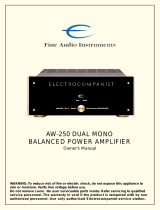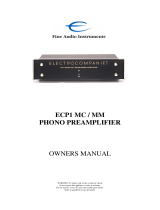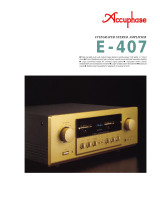Page is loading ...

EC4½ REMOTE CONTROLLED
BALANCED LINE PREAMPLIFIER
Owner’s Manual
WARNING: To reduce risk of fire or electric shock, do not expose this appliance to rain or moisture.
Verify line voltage before use.
Do not remove cover. No user serviceable parts inside. Refer servicing to qualified service personnel.
The warranty in void if the product is tampered with by non authorised personnel. Use only authorised
Electrocompaniet service station.

Welcome to the world of Electrocompaniet
We sincerely thank you for selecting an amplifier from Electrocompaniet. We hope you
will enjoy years of listening pleasure and true high end musical performance from your
audio system. Kindly read this owners manual to familiarise yourself with the set before
operation.
The Electrocompaniet Story
Electrocompaniet was founded in 1973 in Oslo, Norway, to manufacture an amplifier
designed by Per Abrahamsen. The design were based upon a new approach to transis-
tor amplifier design developed by Dr. Matti Otala and Jan Lohstro.
It had long been recognised that transistor amplifiers had a characteristic sound that
many audiophiles and music lovers found unnatural.
Dr. Otala and Mr. Lohstro analysed transistor amplifiers to determine what actually
created the “transistor sound” in general transistorised designs. The results of their
innovative design work were incorporated in the first Electrocompaniet design, the
legendary 25 watt amplifier.
This product were the first commercial transistor amplifier to use this new design
approach, and the amplifier was immediately recognised as dramatically more musical
sounding than any other transistor amplifier. The same design philosophy, has been
constantly updated by additional research and development. This philosophy form the
basis of all the current Electrocompaniet Ampliwire and Preampliwire Dual Mono
Balanced designs.
Electrocompaniet have always given extensive listening test of all it’s designs the
highest priority. Every product designed by our engineers must meet the varied and
exacting standards of the listening panel, carefully selected to represent a cross section
of musical taste and experience. Electrocompaniet designs go back and forth between
the design laboratory and the listening panel until both engineers and listeners are
completely satisfied, and ensured the that the design has met it’s technical and sonic
objectives.
All Electrocompaniet products are handmade by highly skilled technicians, and
extensively tested for maximum performance and reliability.
Final adjustments are made only after an extended period of operation to insure the
best possible performance under conditions similar to those of actual use.
Electrocompaniet Ampliwire and Preampliwire are sold in more than 25 countries ,
providing the ultimate listening pleasure to dedicated music lovers world-wide.

The design features of Preampliwire EC4½
After the Electrocompaniet 25 watt amplifier had established a new standard for transis-
tor amplifiers, research was undertaken to find ways to make the amplifier even better,
and to extend its highly musical sound quality to more powerful amplifier designs. The
engineers at Electrocompaniet were not satisfied by only reducing the commonly
recognised types of distortion to low levels. They recognised that distortion appears in
many forms, and that distortion was still audible in listening tests even when
conventional categories of distortion were at astonishingly low levels.
Traditionally, designers increased feedback to make a larger portion of the output signal
control the amplifiers response. Our listening tests showed us that simply applying
more feedback was not the answer. In fact, as one kind of distortion went down, other
parameters would be adversely affected, leading to an overall degradation of sound
quality. We knew that the other conventional design approach of eliminating feedback
completely was not the answer either, because this would cause high distortion levels,
and as a result would produce a “woolly” sound.
The answer to the dilemma was found in a novel approach to feedback theory. We
developed a feedback concept that allowed local feedback to be applied around indivi-
dual stages of the amplifier circuit. This approach allowed us to avoid the sonic
disadvantages of overall feedback from output to input. The concept was further
developed to reduce phase- and interphase distortion between stages of the amplifier
as well. We were able to concentrate the loop feedback on the stages of the amplifier
where it resulted in audible improvement.
Stability margins were also expanded because feedback no longer affected the frequ-
ency response. The use of this concept of individual gain blocks - complex in design
but simple in function - allowed us to reduce distortion to minute values in all the
products.
The various amplifier stages are divided into two separate sections or gain blocks. The
input block is a transconductance amplifier without overall feedback. This avoids large
output voltage being fed back to the input, and mixed with the minute input signal. The
output block is a transresistance amplifier with parallel feedback. This is done to prevent
higher frequencies than the feedback loop can handle, from entering the loop. An
approach like this will prevent Transient Inter modulation Distortion ( TIM ) and Slewing
Induced Distortion (SID ), eliminating the need for an extremely wide bandwidth.
All stages work in Class A with an efficiency of less than 0,1%. The power supply of the
EC-4 1/5 consists of a 50 VA toroidal transformers , and 10.000 micro farad reservoir
divided into ten 1000 micro farad capacitors, with separate regulator for each stage
and channel. EC 4 1/2 also features a separate powersupply for the digital circuitry( the
remote section), to avoid intereference between the analoge and digital circuitry.

Unpacking the Preamplifier:
Immediately upon receipt of the preamplifier, inspect the carton for possible damage
during shipment. If the carton is visibly damaged, a claim must be filed with the carrier
as soon as possible.
Unpack the unit carefully, and please do remember to save all packaging materials for
future shipment. The carton and packaging have been designed to offer the safest
possible protection when transporting your preamplifier.
The content of the carton is as follows:
1 pcs Electrocompaniet Preampliwire EC4½
1 pcs ECT 1 remote control handset*
1 pcs AC power cord
1 Owners Manual
* ( Optional with or without remote)

Connecting the EC4½ :
Connecting to mains
Check that the mains voltage printed on the rear panel of the preamplifier corresponds
with the line voltage in the territory were you intend to use your preamplifier.
How to avoid damages
A good operating practice is to turn off all equipment before any connections or
disconnection’s are made. Do not under any circumstances connect or disconnect
equipment when power is turned on. If you insist on connecting or disconnecting while
power is turned on, you should be aware that the design of the RCA plug generates a
large transient when inserting the plug. This could damage both the speakers and the
power amplifier.
The rear panel
The rear panel of the Preampliwire EC 4 1/2 contains all input and output connectors.
The printed rear panel clearly indicates the function of each connector.
Single RCA input operation
The single end RCA inputs will work with any line level source. Simply connect the RCA
plugs from the source to the RCA socket. Switch the input selector on the frontpanel of
EC 4 1/2 to single mode.
Balanced XLR input operation
The balanced mode can only be used if the source has a balanced output. In order to
use the balanced XLR input, connect the XLR plugs from the source to the XLR
socket. Switch the input selector on the frontpanel of EC 4 1/2 to balanced mode.

Connecting to the power amplifier:
Single-ended (normal) output and operation
Use the + RCA on right and left channel for connection to the power amplifier.
Balanced XLR output and operation
The balanced mode can only be used if the power amplifier has a balanced input.
Use an XLR interconnect with GND on pin 1, + on pin 2 and - on pin 3.
Balanced RCA output and operation
The balanced mode can only be used if the power amplifier has a balanced input. Be
sure the power amplifier is turned off. Use 2 single (1 stereo) interconnect cables from
the preamplifier to the power amplifier, connecting + and - outputs from the preamplifier
to the
+ and - inputs of the corresponding channel on the power amplifier.
Make sure the + and - are not interchanged, as this will cause the system to operate
out of phase, with very poor bass response as a result.
NEVER use shorting plugs on any output terminal i.e. Rec. out or main out.
How to avoid noise problems
The EC 4 1/2 preamplifier contains circuitry that may be sensitive to magnetic fields.
The unit should be placed well away from transformers etc. Care should also be taken
in routing all signal cables. Do not run signal cables in parallel with speaker or AC
cables ( mains).
Keep cables as short as possible.
If the unit is placed on top of a power amplifier, leave at least 4" ( 10cm) of space
between the two units.
Switches and controls
The power on/off switch is located at the left side of the face plate.The balanced/ single
selector is located at the right side of the faceplate, this button selects either the single
RCA input or the balanced XLR output. The output signal will remain balanced
unaffected by this switch. The volume knob is located at the left side of centre and the
balance knob at the right side of center.The volume and balance functions can be
remote controlled from the ECT1 handset. The four push buttons on ECT1 controls
volume up/down and balance left/ right.

Operating instructions:
How to turn on your system
You should always turn on your equipment in this order: Signal source devices (CD,
tuner, etc) and preamplifier are turned on first. Allow 30 seconds of preheating before
you turn on your power amplifier.When turning your system off, you should start by
switching off your power amplifier, then the preamplifier, and finally your signal source
devices
Warning:
The preamplifier will be warm.
Due to the high class A operating point used in the Electrocompaniet design, it is nor-
mal that the preamplifier feels warm. Proper ventilation will be needed, and the
preamplifier should not be covered in. A good rule is to allow 1 - 2 inches of air
sideways, and 2 - 3 inches above the preamplifier.

Service Policy:
When service is needed
Your dealer will have all relevant information about the service centers in your area, and
will ensure that your unit is serviced without delay. It is our general policy to have your
preamplifier returned to you within 5 working days. This is an average time, and could
vary locally, depending on the work load at the service center.
If, for some reason, there are no service facilities available in your country, please ship
the preamplifier to the following address:
ELECTROCOMPANIET A/S
BREIVIKVEIEN 7
N-4120 TAU, NORWAY
FAX +47 51 74 10 10
E-mail : [email protected]
You are responsible for all shipping charges, insurance, re-importation to your country,
and duty arrangements. When shipping a product to the factory for service, always
include the following:
1) Sales slip or other proof of purchase if repair is claimed under
warranty.
2) Proforma invoice with value of the goods, stating “returned for repair”
3) An accompanying letter describing faults, symptoms, or problems with
the preamplifier.
4) Always ship the preamplifier in its original carton and packaging
material to prevent damage in transit.
Electrocompaniet will not accept responsibility for any damage caused in transit, no
matter how ever caused.
If you require further information concerning the preamplifier operation, or if you have
any questions related to service, please do not hesitate to contact your dealer or natio-
nal Electrocompaniet distributor.

Technical Specifications EC4½ :
The following technical data were measured on randomised test objects and are typical
data. All measurements are made with the following equipment:
Distortion analyser: Tektronix AA501
Oscilloscope: Tektronix 468
Oscillator: Tektronix SG505
Frequency counter: Rascal 9838
Phase meter: Hewlett Packard 3575A
Preamplifier section
Single ended operation (gain) 0 dB
Balanced operation (gain) 6 dB
Input impedance 50 kOhm
THD single ended (1.5 V output) < 0.003 %
THD balanced (1.5 V output) < 0.0015 %
Max. input > 10 V RMS
Channel separation (1 V output, 1 kHz) > 90 dB
Output impedance 100 Ohm
Max. output Single ended 8 V RMS
Max output Balanced 16 V RMS
Output noise 400 Hz - 30 kHz input shorted
Single ended : 6 µV
Balanced : 11 µV
Power consumption (no load or signal) 15 W
Dimensions
Width 483 mm / 19 inches
Depth 240 mm / 9.5 inches
Height 70 mm / 2.8 inches
Weight 5 kg. / 11 lbs.
The manufacturer reserves the right to alter these specifications without further notice.
/






